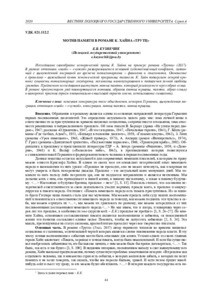Please use this identifier to cite or link to this item:
https://elib.psu.by/handle/123456789/24561Full metadata record
| DC Field | Value | Language |
|---|---|---|
| dc.contributor.author | Кузнечик, Е. В. | - |
| dc.contributor.author | Kuznechyk, K. | - |
| dc.date.accessioned | 2020-04-09T05:53:03Z | - |
| dc.date.available | 2020-04-09T05:53:03Z | - |
| dc.date.issued | 2020 | - |
| dc.identifier.citation | Кузнечик, Е. В. Мотив памяти в романе К. Хайна «Трутц» / Е. В. Кузнечик // Вестник Полоцкого государственного университета. Серия A, Гуманитарные науки. - 2020. - № 2. - С. 44-48. | ru_RU |
| dc.identifier.issn | 2070-1608 | - |
| dc.identifier.uri | https://elib.psu.by/handle/123456789/24561 | - |
| dc.description.abstract | Исследовано своеобразие исторической прозы К. Хайна на примере романа «Трутц» (2017). В рамках оппозиции «свой» – «чужой» разворачивается основной художественный конфликт, связанный с вынужденной миграцией во времена тоталитаризма – фашизма и сталинизма. Отношение к прошлому – важнейший пункт эстетической программы писателя. К. Хайн подвергает острой критике сущность тоталитарных государств, механизмы манипулирования и подавления личной свободы граждан. Предметом исследования выступает мотив памяти, который реализуется через образ семьи. В романе присутствует ряд повторяющихся мотивов, образов (мотив травмы, памяти, образ семьи) и авторских приемов (прием эмоционально-смысловой окраски имени, использование символики).= The analysis of the historical originality of C. Hein based on the "Trutz" (2017) novel is carried out. The main conflict, “friend” – “foe” opposition, is represented by forced migration in two totalitarian systems, fascism and Stalinism. Dealing with the past is the most important point of the writer’s aesthetic program. C. Hein sharply criticizes the essence of totalitarian states, the mechanisms of manipulation and suppression of citizen’s personal freedom. The study subject is the memory motif, which is realized through the image of the family. There are repeating motifs, images (the motif of trauma, memory, the image of the family) and author’s techniques (emotional-semantic nuance of the name, using of symbolism). | ru_RU |
| dc.language.iso | ru | ru_RU |
| dc.publisher | Полоцкий государственный университет | ru_RU |
| dc.relation.ispartof | Веснік Полацкага дзяржаўнага ўніверсітэта. Серыя А, Гуманітарныя навук | be_BE |
| dc.relation.ispartof | Herald of Polotsk State University Series A, Humanity sciences | en_EN |
| dc.relation.ispartof | Вестник Полоцкого государственного университета. Серия A, Гуманитарные науки | ru_RU |
| dc.relation.ispartofseries | Серия A, Гуманитарные науки;2020. - № 2 | - |
| dc.rights | open access | ru_RU |
| dc.subject | Государственный рубрикатор НТИ - ВИНИТИ::ОБЩЕСТВЕННЫЕ НАУКИ::Литература. Литературоведение. Устное народное творчество | ru_RU |
| dc.subject | Немецкая литература после объединения | ru_RU |
| dc.subject | История Германии | ru_RU |
| dc.subject | Вынужденная миграция | ru_RU |
| dc.subject | Оппозиция «свой» – «чужой» | ru_RU |
| dc.subject | Интеграция | ru_RU |
| dc.subject | Мотив памяти | ru_RU |
| dc.subject | Мотив травмы | ru_RU |
| dc.subject | German literature after reunification | ru_RU |
| dc.subject | History of Germany | ru_RU |
| dc.subject | Forced migration | ru_RU |
| dc.subject | “Friend” – “foe” opposition | ru_RU |
| dc.subject | Integration | ru_RU |
| dc.subject | Motif of memory | ru_RU |
| dc.title | Мотив памяти в романе К. Хайна «Трутц» | ru_RU |
| dc.title.alternative | The Motif of Memory in C. Hein’s Trutz | ru_RU |
| dc.type | Article | ru_RU |
| dc.identifier.udc | 821.112.2 | - |
| Appears in Collections: | 2020, № 2 | |
Items in DSpace are protected by copyright, with all rights reserved, unless otherwise indicated.
